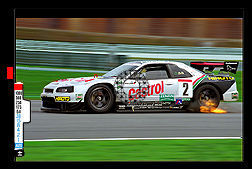With the SLR, there is virtually no limit to focal length usage. One of the aspects responsible for the popularity of 35mm SLR photography taking off so rapidly during the sixties and seventies is of the rangefinder camera's limited ability to focus long lenses - 135mm is the longest focal length for any rangefinder model. The single lens reflex camera revolutionized the world of telephoto lens use. The 300mm is one of the most popular focal lengths and almost treated like a "standard lens" - a bare minimum requirement with hard working professionals or serious amateurs who engages in action based sports, wildlife, photojournalism or even fashion and industrial photography.
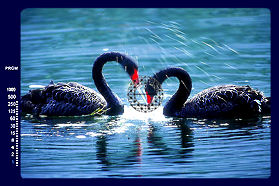 |
Even when the Olympus OM2 was introduced during mid- of '70, Olympus had only a lens each offered at 300mm, 400mm, 500mm, 600 and 1000mm focal length. The original F-Zuiko Auto-T 300mm f/4.5 seems has little changed optically and retained the original optical construction of 6 elements in 4 groups and focuses at closest distance of 3.5m (11.5ft), uses 72mm filter accessories and both stay at the same length at 181mm. |
<<<<<<,,,,. Black Swans(42k Jpeg). A rare scene at a lake in Pakistan. Copyright © 2000 Photo courtesy of Mr. MCLau ∝
However, as Olympus claimed, the lens coating of the upgrade has improved the light transmission, reduced internal reflections between lens elements, render a more faithful color rendition. I would like to believe the 300mm f/4.5 had at least gone through some research for improvements. The newer version of the 300mm has successfully managed to trim down the weight by 80g to 1,020g (from 1.1kg).
But the real treat from Olympus was not focused at the 300mm which has been around since the inception of their original Olympus M1/OM1 back in 1972/3. Along with the introduction of the OM3/4 during the early '80, two stunning high speed Zuiko super-telephoto lenses of 250mm f/2.0 and 350mm f/2.8 were also been introduced at almost the same timing which had the photographic community rocked by the two gigantic optics. Although Olympus claimed both are the fastest lens in their respective focal length, but since these two 250mm and 350mm were cleverly selected by Olympus and no other 35mm system has such similar offerings, Olympus can well safely retained the crowned "World's fastest...." for a long long time..
Anyway, joke asided. Why did I said "cleverly" when referring to these two focal length chosen by Olympus ? If you think more about it, it makes a lot of sense. For those who often uses the 300mm f/2.8 lens may understand what I meant, but firstly you need to understand more about super telephoto lenses. Generally, this lens type provides tremendous image magnification. The 300mm has about 1/6th the angle of view of a 50mm normal lens. It takes 1/36th of the area covered by a 50mm to fill the 35mm frame. Viewed from another angle, taking a tiny 4x6mm section of a 35mm negative made with a 50mm lens and enlarging it to full frame equals the coverage of the 300mm. For an overall full length view you would have to step back to about 15 meters (46 ft.).
The distance from the lens mount surface to the focal plane is called the flange back. Olympus SLRs has a slightly longer distance of 46mm compared to other camera makers (Canon SLR is 42mm, Nikon has almost identical at 46.5mm). Subtracting 46mm from 300mm means that a 300mm lens normally would be 255mm long. Generally, lenses shorter than 254mm thereby would increase handling ease. The Zuiko 300mm f/4.5 is posts the best telephoto ratio among all telephoto lenses between 250mm and 400mm within the Zuiko lens series.
|
Lens Type |
length |
Flange back |
A+B |
Focal length |
Telephoto Ratio |
|
Zuiko 250mm f/2.0 |
246mm |
46mm |
292 |
250mm |
0.98 |
|
Zuiko 300mm f4.5 |
181mm |
46mm |
272 |
300mm |
0.60 |
|
Zuiko 350mm f2.8 |
280mm |
46mm |
326 |
350mm |
0.80 |
|
Zuiko 400mm f6.3 |
256mm |
46mm |
302 |
400mm |
0.64 |
The telephoto ratio in the table is the overall length of the lens in relation to its focal length. The smaller the ratio, the smaller the lens. At one time it was automatically accepted by designers that there had to be 300 millimeters between the lens and the focal plane in a 300mm lens design. Part of this length is the width of the camera body itself. The lens mount also accounts for part of the overall size.
Depending on nature of jobs/assignments, most would consider the 300mm is the bare minimum for sports and even wildlife photography. Ideally, one would think lenses of 400 onwards to 800mm with reasonably good lens speed are more ideally suited for such applications - but since higher lens speed usually means heavy and bulky physical lens body where it restricts mobility and portability for any photographer. Thus, lenses between 400mm to 600mm which has longer reach than those of 300mm has more practical value on the field.
<<<<<<,,,,. Nissan Skyline in GT race 2000, Sepang F-1 Circuit, Kuala Lumpur. (42k Jpeg). Copyright © 2000 Photo courtesy of Mr. Abdul Shukor bin Mohd Janis ∝ Note: Nissan Website is developed by MIR.
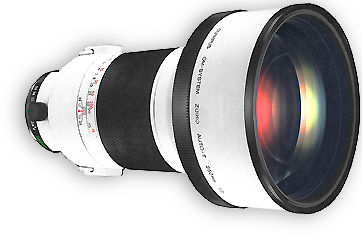 |
So instead of un-decidingly whether to invest into a 300mm f2.8 or 400mm f/2.8 lens, now you can have a mid-between range of 350mm at the same lens speed. If your priority is on fast maximum aperture, just compromise 50mm reach from 300mm focal length, you will have a full f-stop faster with a f/2.0 lens. |
Anyway, there are some factors you must bear in mind when use with such optics. Careful consideration should be given to focusing with telephoto lenses due to the extreme shallow depth of field. Basically, for those who have experiences with using focal lengths above 300mm can easily tell you what the main problem could be, other than the weight which restrict mobility, it is the working shutter speed and control of depth of field. Anyway, common ways to tackle such issues is to culture a good shooting habit of always getting your camera supported, next is to use film of higher speed to shoot at relatively small apertures and fast shutter speeds.
The effect of compressed perspective and shallow depth of field is even greater with the lenses of these focal lengths compared with shorter focal length of telephoto lenses. This adds to your ability to control the appearance of the final image. The 300mm is a good choice for sports, nature, news and even fashion photography. Compared with a wide-angle lens that covers a tremendous-subject area, such lenses reaches out to magnify the subject and at the same time eliminates distracting elements in the photograph.
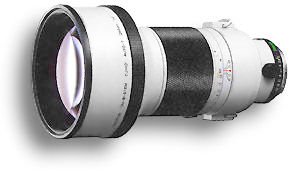 |
Zuiko 250mm F2.0 EDIF |
Uniform performance is maintained by a unique inner focusing system, while special optical glasses assure superb resolution. A massive 3.9kg and a telephoto ratio of 9.8 but still able to achieve a remarkable close focus distance of merely 2.2m (7.2ft).
However, Olympus warned this lens is not designed to use in Programmed AE mode with OM2SP, OM40 or other equivalent bodies. I have seen a unit of this lens in one of the used outlet asking for USD4,350-00, that is real stiff if just meant for some weekend portraits for your new girl friend(s) ... (Obviously, you will only need a 100mm for your existing gal friend..may be 50mm is good enough...). To extend its reach, the use of a 1.4X teleconverter will tranform this gigantic lens into another beast, a 492mm f4.0 super telephoto lens !
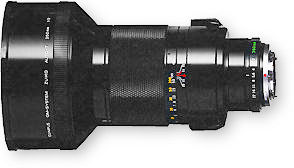 |
Specifications |
Distance scale: (m)
2.2m (7.2ft) to infinity (OO)
Focusing:
Internal Focus mechanism
Minimum and Maximum aperture: f/22-f/2.0
Tele-Converter:
1.4X A
Diaphragm:
Automatic
Filter size: Slip-in type Rear filter
Length: 246mm
Weight: 3,900g (137.6 oz)
Recommended
Focusing Screens: 1:1*,
1:2*,
1:3*,
1:4n*,
1:6#,
1:7#,
1:10*,
1:13*,
1:14*
*
Compatible.
Focusing and exposure accuracy remains #
Can be used, they provide accurate focusing but exposure error may
occur
in manual mode for OM1 and OM2 series models. Warning:
Programmed AE mode in OM2SP, OM40 or others are not usable with this lens.
A compromised selection, blending practical focal length, weight and size into an economical package. Although it has never been hailed as a Olympus classic, but I heard some good reviews and comments on this lens and actually seen some very eye-catching images taken with this lens as well. Consistent color fidelity and high contrast images despite never labeled to used any rare earth glass in its optical composition.
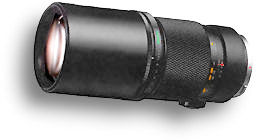 |
Zuiko 300mm F4.5 |
A good choice for sports, wildlife and landscape photography if portability is your priority as it stops down to f/32 for maximum depth of field control and weighs only 1/4 of the Zuiko 250mm f2.0. Main drawback is its close focus ability, it can focuses down at a moderate 3.5m (11.5ft) and uses non-OM standard 72mm and may post some compatibility with other common OM filter accessories carrying 49mm filter diameter.
It retails new at around USD700-00 but could be halved at used unit. Obviously, third party lenses such as Tamron ED-Zoom 200-400mm (USD450-00), a Sigma 135mm-400 f/4.5-f/5.6 APO Aspherical (USD550-00) or a Tokina 80-40 f/4.5-f/5.6 ATX series(USD540-00) would make more sense if you can't afford a new lens at USD700-00. Anyway, that is exactly the main problems faced by virtually all camera makers who also produces lens for their cameras. Anyway, I am not indicating third party lenses has superiority over the Zuiko in this respect, I am just trying to stress the point of how to get maximum value and benefit out of the hard earned Vitamin "M" in our wallet - or could it be the Zuiko lenses over priced by retailers ?
| Specifications Len type: Zuiko 300mm f/4.5 Focal length: 300mm Lens construction: 4groups, 6 elements Angles of view: Diagonal: 8‘ * More info on "Picture Angle". Distance scale: (m) 3.5m (11.5ft) to infinity (OO) Focusing: Helicoid Minimum and Maximum aperture: f/32-f/4.5 Diaphragm: Automatic Tele-Converter: 1.4X A Filter size: 72mm Length: 181mm Weight: 1,020g (36 oz) Recommended Focusing Screens: 1:1*, 1:2*, 1:3*, 1:4n*, 1:6#, 1:7#, 1:10*, 1:13*, 1:14* * Compatible. Focusing and exposure accuracy remains # Can be used, they provide accurate focusing but exposure error may occur in manual mode for OM1 and OM2 series models. |
Specifications Len type: F-Zuiko Auto-T 300mm f/4.5 Focal length: 300mm Lens construction: 4 groups, 6 elements Angles of view: Diagonal: 8‘ Distance scale: (m) 3.5m (11.5ft) to infinity (OO) Focusing: Helicoid Minimum and Maximum aperture: f/32-f/4.5 Diaphragm: Automatic Filter size: 72mm Length: 181mm Weight: 1,100g (38.8 oz) Recommended Focusing Screens: 1:1*, 1:2*, 1:3*, 1:4n*, 1:6#, 1:7#, 1:10*, 1:13*, 1:14* * Compatible. Focusing and exposure accuracy remains # Can be used, they provide accurate focusing but exposure error may occur in manual mode for OM1 and OM2 series models. |
| Previous | Next | The Zuiko 350mm f2.8 EDIF, 400mm f6.3 ...
